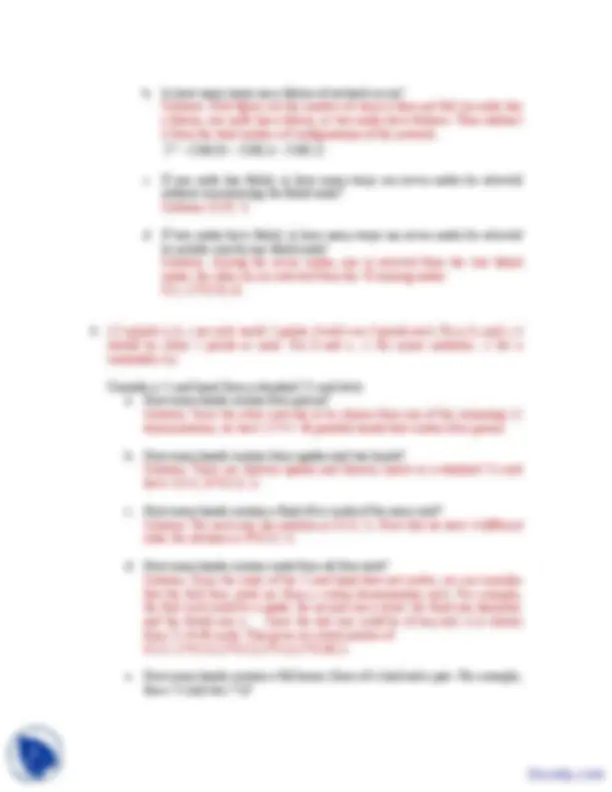




Study with the several resources on Docsity

Earn points by helping other students or get them with a premium plan


Prepare for your exams
Study with the several resources on Docsity

Earn points to download
Earn points by helping other students or get them with a premium plan
Community
Ask the community for help and clear up your study doubts
Discover the best universities in your country according to Docsity users
Free resources
Download our free guides on studying techniques, anxiety management strategies, and thesis advice from Docsity tutors
During the study of discrete mathematics, I found this course very informative and applicable.The main points in these lecture slides are:Pigeonhole Principle, Line Segment, Equilateral Triangle, Consecutive Set, Binomial Theorem, Coefficient of Expansion, Direct Application of Binomial Theorem, Failure of Network, Number of Configurations
Typology: Slides
1 / 4

This page cannot be seen from the preview
Don't miss anything!



Use Pigeonhole Principle to prove followings: a. Suppose each point of the plane is color green or yellow. Prove that some line segment has ends in the same color.
Solution: (Draw a line segment on the plane. Arbitrarily pick a point on this line segment, say, its midpoint. Now we have 3 points, two ends and a midpoint. According to the pigeonhole principle, at least 2 points are of the same color. Use these two points as the endpoints to construct the line segment we want, namely, a line segment with both ends in the same color.)
Actually, the most general way to think of this problem is arbitrarily pick 3 points on the plane. According to PHP, there must be two points of the same color. Connect these two points to make a line segment.
b. Show that if we randomly choose 17 points within an equilateral triangle (with its side equal to 1), there must be a pair of points at a distance less than 0.25.
Solution: As the picture shows, an equilateral triangle can be divided into 16 smaller equilateral triangles. It is easy to verify that the side of each small triangle is 0.25. Now that we have 17 points, according to the pigeonhole principle, at least two points are inside the same small triangle. This means that the distance between these two points can’t exceed 0.25.
c. If 9 balls are to be placed in a row of 12 bins (one bin can hold only one ball), there must be a consecutive set of 3 bins that are filled with balls.
Solution: 9 balls and 12 bins implies that there are 3 empty bins. These 3 empty bins partition the filled bins into 4 groups of consecutive filled bins (it is possible that one or more groups of consecutive filled bins are “empty set”). Since 2<9/4<3 and according to the pigeonhole principle, there must be a consecutive set of 3 bins that are filled with balls.
Binomial Theorem:
a. Find the 6th^ term in the expansion of 3 10
( x ) x
−. Then find the coefficient
of (^14)
x
in this expansion.
Solution: 6th^ term: (^5 3 )
C (10,5)( x ( ) ) C(10,5) x x
Coefficient of (^14)
x
b. Use the binomial theorem twice to expand ( x + y + z)^3. Solution: 3 3 3 2 2 3 3 2 2 3 2 2 2 2 3 3 2 2 3 2 2 3 2 2
x y z x y z C x y C x y z C x y z C z C x C x y C xy C y x xy y z xz yz z x x y x z y y x y z z z x z y xyz
c. Use the binomial theorem to prove that C n ( , 0) + C n( ,1)2 + C n( , 2)2 2 + ⋅⋅⋅ + C n n( , )2 n^ = 3 n Solution: Notice that 3=1+2 and 1 n^ = 1 , the equation can be transformed into C n ( , 0)1 n ⋅ 20 + C n( ,1)1 n −^1 ⋅ 2 + C n( , 2)1 n^ −^2 ⋅ 22 + ⋅⋅⋅ + C n n( , )1^0 ⋅ 2 n^ = (1 +2)n And this is the direct application of binomial theorem.
Consider a computer network with 60 switching nodes. The network is designed to withstand the failure of any two nodes. a. In how many ways can one or two nodes fail? Solution: C(60, 1) + C(60, 2)
Solution: Each denomination has 4 cards. Choosing 3 among 4 gives us C(4, 3). Then we need to choose the pair from the remaining 12 denominations. So, for three of a fixed kind, we have C(4,3)12C(4,2). Since there are 13 denominations altogether, the total number is 1312C(4,3)*C(4,2).